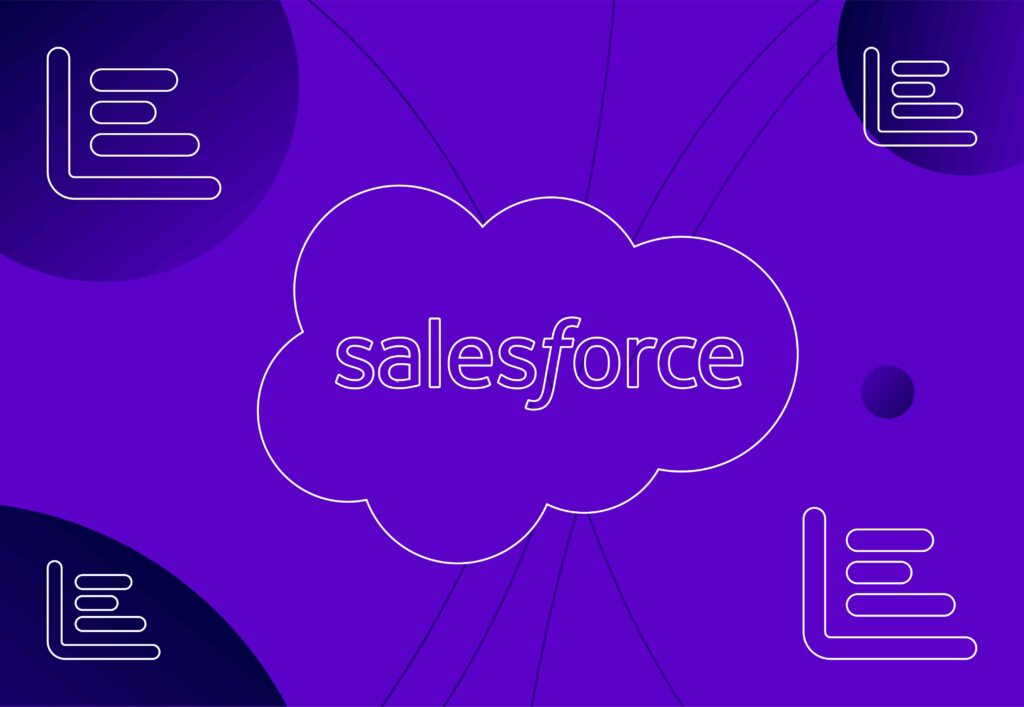
29 Salesforce stats that show the power of a CRM

A CRM (customer relationship management) system is a key component of any successful business. It enables businesses to effectively manage customer interactions, track new business opportunities, personalise communication, automate repetitive tasks, and improve customer retention by helping establish strong relationships.
There are hundreds of CRM software providers available, but one that stands out is Salesforce. Like many of its competitors, Salesforce is a cloud-based software company that offers businesses a premium solution for managing customer relationships and improving sales and marketing.
In this blog, we’re going to look at the numbers behind the history of Salesforce, and how the company has grown to be so popular and dominant in the CRM market.
Stats about the history of Salesforce
Salesforce’s history is interesting and includes milestones and challenges. It began in early 1999 when former Oracle executive Marc Benioff founded the SaaS company. The prototype was launched later that year, in November. Following the launch, Salesforce received investment from Larry Ellison, the co-founder of Oracle, and Halsey Minor, the founder of CNET.
Below is an image of the San Francisco skyline and the tower in the middle with the top section lit up blue is the Salesforce Tower.

With this backing, it seemed the San Francisco-based business was destined for greatness, however just one year after trading, Salesforce was impacted by the millennium dot-com crash and had to reduce its workforce by 20%.
Following this initial blip, the company regained its strength in 2001, seeing its customers surpass 3000 and making it the fastest-growing CRM company at the time. The success continued and saw Salesforce achieve the following:
- Between 2001 and 2003, Salesforce’s revenue grew from $5.4 million to over $100 million (source).
- The 2003 growth then resulted in the company holding its first conference called Dreamforce, which would then go on to be an annual event (source).
- Salesforce’s success led to the company being listed on the New York Stock Exchange in 2024. Using the symbol CRM it raised $110 million (source).
- 10 years after launching, Salesforce expanded its offering with ‘Service Cloud’ which brought customer service and automation support to its clients.
- In 2009 Salesforce grew its customer base to 72,000 and revenue rose over 20% to $1.3 billion.
- 20 years after launching Salesforce acquired Tableau, combining the world’s number 1 CRM and number 1 analytics platform under one business.
So since launching 26 years ago, Salesforce has achieved an awful lot and it’s not surprising that the brand has grown into a global brand dominating the market.
Stats about Salesforce and the market
Salesforce operates in a highly competitive market, however having been around since the late nineties, it has created a legacy that has enabled it to dominate the market.
- It is reported that Salesforce owns 22% of the market, over three times that owned by Microsoft in second place (source).
- In 2024, and for the 11th consecutive year running, Salesforce was ranked the number one CRM provider (source).
- The global CRM market that Salesforce is a part of is estimated to grow to be worth $145.79 billion by 2029 (source).
- As well as becoming the number one CRM platform, Salesforce is ranked number 4 on the Fortune 100 list of worldwide employers. Whilst an achievement, it’s not surprising that the company employs over 80,000 employees (source).
So now we’ve looked at the history and growth of the company, let’s look into the people and businesses that use the platform.
Stats about Salesforce customers
Salesforce is used by over 150,000 users worldwide and has some of the biggest brands in the world as customers, including Toyota, Spotify, BMW and American Express.
Some more stats on Salesforce customers include:
- Over 59% of their customers are based in the USA
- The UK is Salesforce’s second-largest market, accounting for 13.9% of users
- 49% of customers are businesses with under 50 employees
- 11% of customers are businesses with over 1000 employees
- 34.3% of customers are classed as professional services, followed by 15.5 as financial services and 11.1% as manufacturing
Stats about Salesforce and productivity
Salesforce offers its customers a wide range of products that are constantly evolving to meet their needs. Some products include; Agentforce which enables users to create AI agents to support their business, Data Cloud which unifies user data to personalise engagements on scale, and communication platform Slack which they acquired in 2020.
Following the implementation of Salesforce into their businesses, users said:
- 29% saw an increase in productivity
- 27% saw a reduction in support costs
- 27% saw a decrease in costs to acquire new customers
- 25% saw a decrease in IT-related costs (source)
It has also been found that companies using Salesforce:
- 30% saw it improved customer satisfaction
- 25% experienced operational improvements
- 22% said it increased the rate of R&D (source)
Stats about Salesforce and it’s marketing
So we’ve learnt how Salesforce has dominated the market by offering a product that customers love and acquiring other businesses to strengthen their offerings. However, it’s not just enough to have a great product, you need to also be able to take that product to market and promote it to potential customers to keep growing. This is where Salesforce’s brand and marketing activities come in, along with the Salesforce characters.

Knowing the topic of CRM and technology Salesforce offers isn’t the most fun or visually appealing, the company created a group of mascots in the hope of humanising tech and making it more engaging. The initial mascot launched in 1999 was SaaSy who was then joined in 2014 by Astro and his 10 friends including, Appy the bobcat, Brandy the fox and Codey the bear. Each mascot has its experience and purpose and as such is used in marketing that area or function of Salesforce. To engage clients further, they can even take part in mascot quizzes, helping users learn more about the platform in a gaming manner.
However, it’s not just mascots that have enabled Salesforce to scale. Here is a selection of stats that show the numbers behind its marketing activities.
- In 2024, 15% of Salesforce revenue ($4.9 billion) came from marketing (source).
- In 2024, it has also been reported that Salesforce spent $12.88 billion on marketing and sales (source).
- In just under 10 years, Salesforce has scaled its marketing spend by almost $10 billion (source).
Figures like those, show just how much emphasis the platform places on marketing as part of its business growth strategy.
The importance of a CRM
As we touched on at the beginning of this blog post, CRM is a vital part of a successful business, especially as customers are putting more emphasis on brands offering a personalised service that goes above and beyond.

As the market leader we’ve gone into detail about Salesforce, however, there are many other CRM systems out there. Here’s a brief look at some of Salesforce’s competitors:
HubSpot
Similar to Salesforce, HubSpot has been around for over a decade, the platform combines a CRM with a range of tools to support marketing, sales and content creation.
Over 238,000 businesses use HubSpot, so it’s a popular tool of choice, and this could be down to the ease of use, the AI-powered assistant and a free version with no time limit. However, like many of the CRM platforms out there the more features and technical abilities you want your system to have, the more you’re going to have to pay and learn.
Zoho CRM
Just older than Salesforce, Zoho launched as AdventNet in 1996 before releasing the CRM in 2005 and rebranding to Zoho Corporation in 2009. The platform offers a range of price packages for professional to enterprise levels.
When comparing Zoho to Salesforce, the user interface isn’t as design-friendly and most of the more advanced features are only available to those users who pay the higher prices.
Zendesk
Originally a help desk software, Zendesk branched out into CRM, helping businesses to offer an exceptional customer experience. Unlike Salesforce and HubSpot, it doesn’t offer as many marketing automation features.
If you’re already a Zendesk customer then it’s probably a good idea to use the CRM too, and the platform has helpful reporting options and easy onboarding. However, it has limited pipelines, a basic email editor, and quickly gets expensive.
Monday.com
Advertised as ‘a CRM you’d actually want to use’ Monday.com focuses on automating repetitive tasks so you can spend more time on sales. The platform has a range of features and packages available, and even compares the platform to others in the market for factors such as ‘ease of use’ and ‘ease of setup’.
Despite offering CRM functionality, Monday.com is actually a project management tool. Therefore if you were to use the platform as a CRM and for managing projects, it might be a more cost-effective solution.
ClickUp
Similar to Monday.com in that ClickUp is technically a project management software with the ability to be used as a CRM. By using the tool for multiple purposes, businesses can save themselves time and money, by not having to switch between different tools and platforms.
So there is a short summary of a few other CRM platforms available. When it comes to choosing a CRM you should start by analysing what you need support with and then doing further research to see which platform will best help you achieve your goals.
Conclusion
From market share to customer success, the data shows, that Salesforce isn’t just a CRM it’s a powerful business helping other businesses to drive growth and innovation across the world.
However, that doesn’t mean that it’s the perfect platform for you and your business. Remember, when it comes to implementing technology into your business you should conduct your own research and ensure you choose the right provider for you, your goals and your infrastructure.
With the right tools, technology and partners, you should also see your business grow. If you’re not happy with the growth or the results you’re experiencing then it could be due to an issue with the tools, tech or partners your business with. If it is something that is marketing related then this is where we could help you, and our team would be willing to discuss your goals and activities with you.
Deeper insights
Find out more about other marketing and business technology by reading these blogs:



